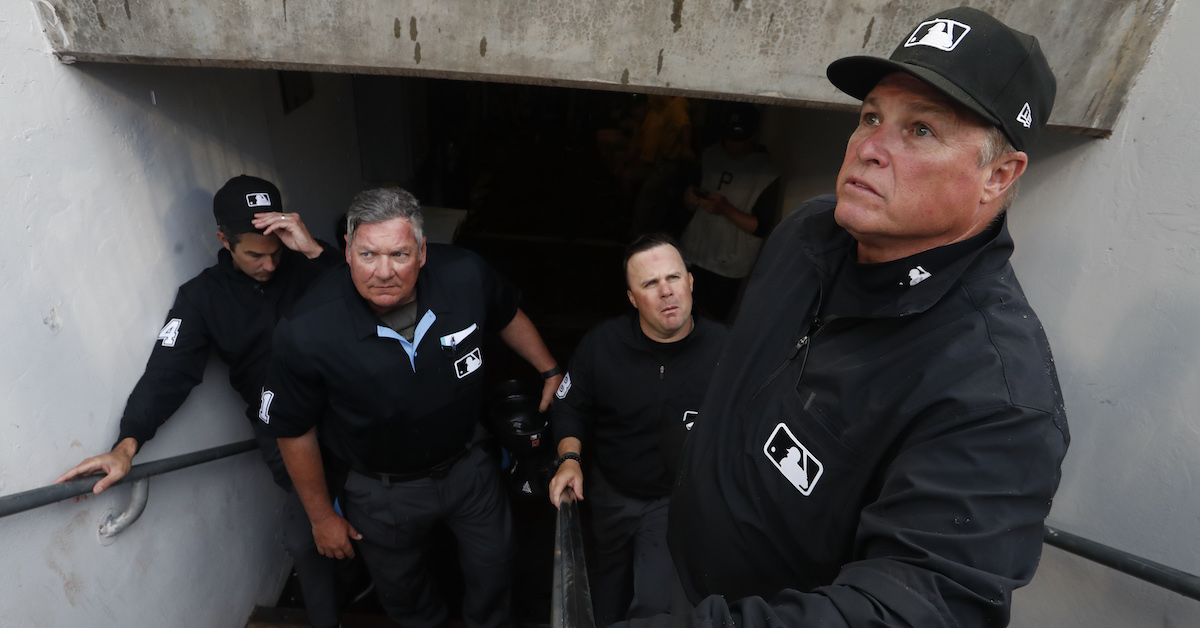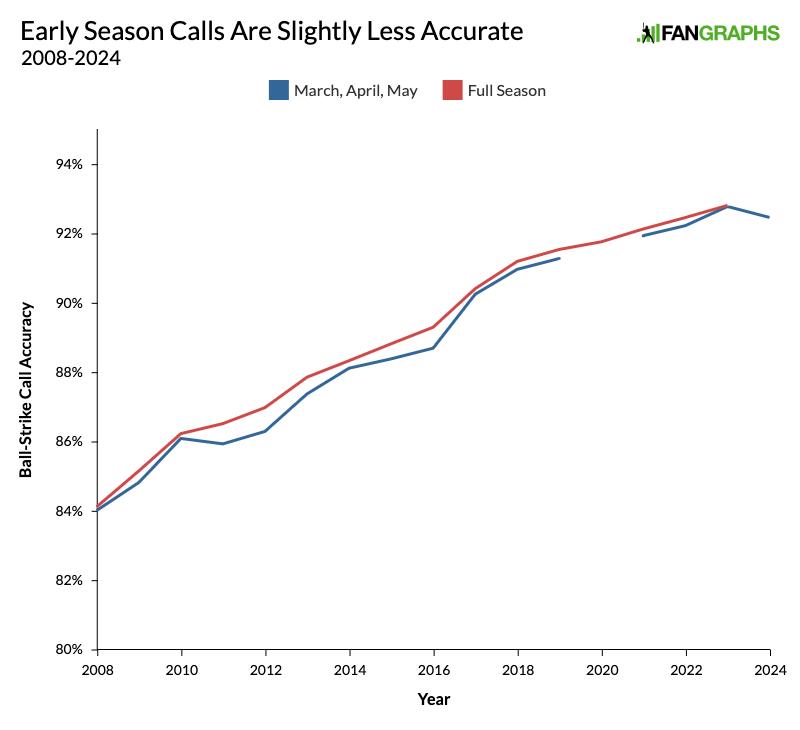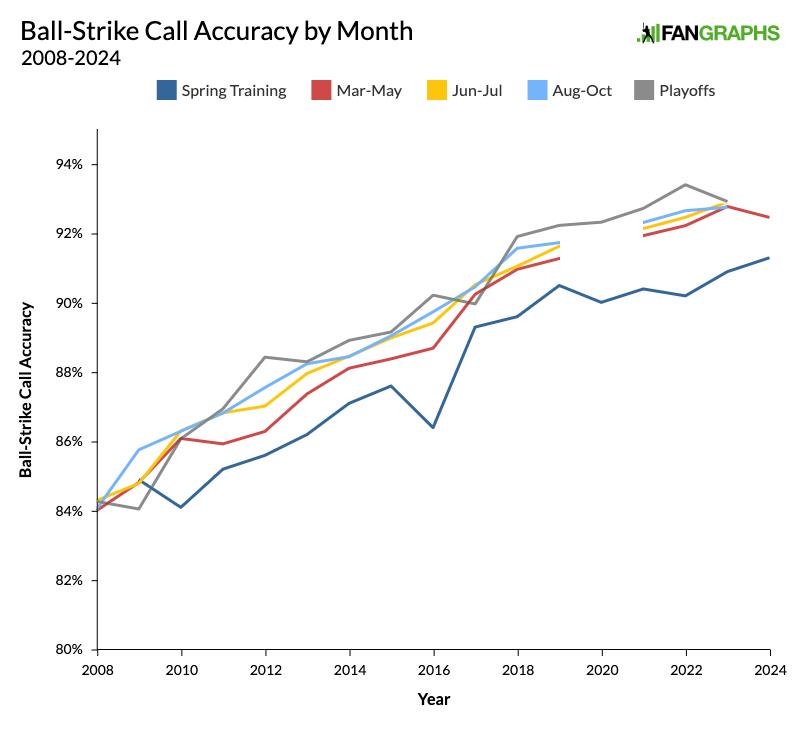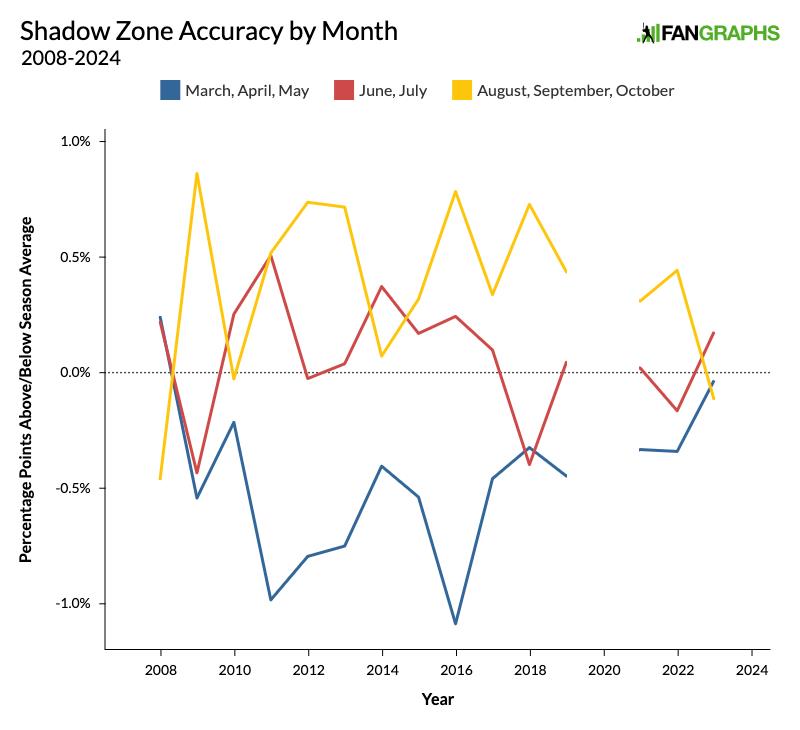
Charles LeClaire-USA TODAY Sports
For the last few years, I’ve been checking the accuracy rate of the ball-strike calls made by umpires, dividing the number of correct calls by the total number of takes. It’s a blunt approach, but because umpires make so many thousands of calls each year, it yields solid results. On Tuesday, I pulled the numbers for the 2024 season, and I found something I didn’t expect: Accuracy is going down rather than up. In every single season since the beginning of the pitch tracking era in 2008, umpires have gotten better at calling balls and strikes according to the Statcast strike zone. This is the first time I’ve ever pulled the numbers and seen a lower accuracy rate. However, this is also the first time I’ve checked the numbers this early in the season, and it turns out umpires tend to make better calls as the season goes on. Since 2017, accuracy in March, April, and May has been 0.19 percentage points lower than accuracy over the full season (though the difference in 2023 was just 0.03 percentage points). Here’s what that looks like in a graph.

You know how at the beginning of every season, there are a couple blown calls during a nationally televised game (or at least, calls that appeared to be wrong according to the on-screen strike zone), and certain people start complaining that umpires are terrible and they’re getting worse? Those people always catch me off guard. I usually forget about the missed calls when the season ends, but those people somehow manage to keep their umpire anger at a high idle through the entirety of the offseason so that the instant baseball returns, they’re ready to shout about the umpires again without any need to ramp up. I don’t know how they do it without pulling an oblique, but in a sense, those angry people are right. Even though the umpires are always getting better year after year, they’re nearly always more accurate toward the end of the season than at the beginning — so much so that when the season starts, they’re worse than they were at the end of the previous season. For a month or two, the umpires really have gotten worse. We often say early in the season that pitchers are ahead of hitters. It turns out they’re ahead of umpires too.
For each season, I broke down the overall accuracy in two-month increments, essentially dividing the season into thirds. I also broke down the accuracy during spring training and the playoffs, although there are plenty of factors that make those numbers suspect. During spring training, the umpiring pool is much wider. Perhaps more importantly, there are far, far fewer tracked pitches during spring training, both because the number of games is so small and because not every stadium is set up for Statcast. That results in a much smaller, much less reliable sample. The playoffs are also a much smaller sample, but they’re also, at least in theory, selecting for better umpires. Working the playoffs is seen as an honor and a reward for performing well in the regular season. We should expect accuracy to be at its lowest during spring training and highest during the playoffs.

Generally speaking, the results fit our preconceptions. Spring training accuracy is very low and it features the volatility that we’d expect from a small dataset. Umpires are also more accurate in the playoffs. The red line is March, April and May, and as you can see, it’s nearly always below everything but the spring training line. Not only do umpires start getting better in June, but they keep getting better right through the end of the season, which is why the light blue line for August, September, and October is usually above the yellow line for June and July. The trend is a little bit easier to see if we focus just on pitches in the shadow zone, the area that’s one baseball’s width from the edge of the zone on either side.

In the graph above, the dotted line represents that season’s overall accuracy on calls in the shadow zone. Each data point represents the number of percentage points above or below that year’s average. Not only do the calls get better as the season goes on, there’s a definite gap between the first two months and the rest of the season. Umpires are decidedly worse in those first two months. However, 2023 was a real outlier. It was first time since 2008 that umpires were more accurate in the beginning of the season than the end.
With that, I want to bring you back to 2024. So far this season, umpires have gotten 92.46% of calls right, down from 92.81% in 2023 and just two thousandths of a percentage point higher than in 2022. Based on everything I’ve shown you, we should expect umpires to get better over the rest of the season. However, the drop-off from last year is noticeable. Accuracy over the first two months of the season has only fallen once before, from 2009 to 2010, when it dropped by 0.16 percentage points. So far this season, accuracy has fallen by twice that amount: 0.32 percentage points. That’s a tiny change, on the order of one call per game, but that doesn’t make it any less real. We’ll have to wait and see how the rest of the season goes, but perhaps this year really could end up being different. Or, if it follows the pattern of the past decade and a half, accuracy will soon be in its way up.
Source
https://blogs.fangraphs.com/umpiring-is-about-to-get-better/
 Backyard GrillingWeekend WarriorsAdvice from DadBeard GroomingTV Shows for Guys4x4 Off-Road CarsMens FashionSports NewsAncient Archeology World NewsPrivacy PolicyTerms And Conditions
Backyard GrillingWeekend WarriorsAdvice from DadBeard GroomingTV Shows for Guys4x4 Off-Road CarsMens FashionSports NewsAncient Archeology World NewsPrivacy PolicyTerms And Conditions
